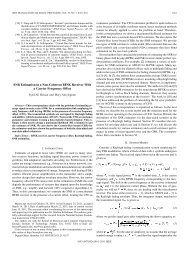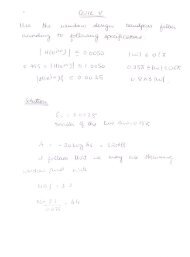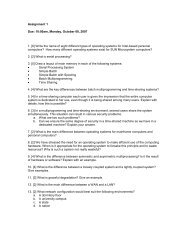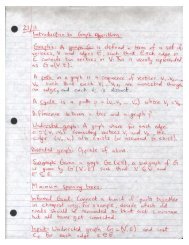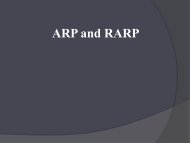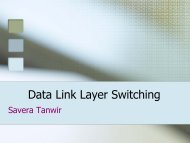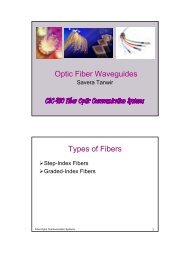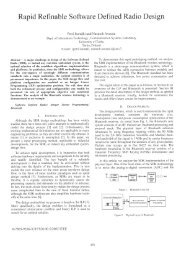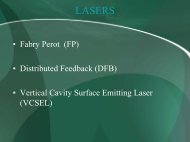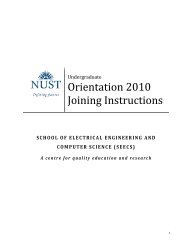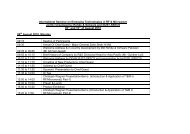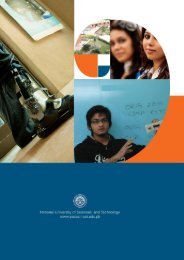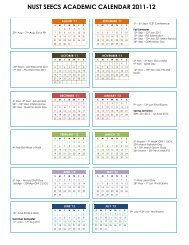Download
Download
Download
Create successful ePaper yourself
Turn your PDF publications into a flip-book with our unique Google optimized e-Paper software.
Free space optical (FSO) link design<br />
under diverse weather conditions<br />
Z. Salem, N. Khan, W. Ishaq,<br />
zahid_saleem@comsats.edu.pk<br />
nasrullahk@yahoo.com<br />
wishaq@gmu.edu
Out line<br />
Link design<br />
Impact of atmosphere on FSO<br />
Absorption & Scattering<br />
Turbulent media<br />
Turbid media<br />
Link margin<br />
Results<br />
Limitations<br />
Conclusions<br />
Question
Link design
Link design<br />
The main objective of FSO link design is to get as much<br />
light as possible from one end to the other, in order to<br />
receive a stronger signal that would result in higher link<br />
margin and greater link availability<br />
Link design parameters consists of two parts<br />
Internal system parameters ( system related parameters)<br />
External system parameters( Link related parameters)
It consists of …<br />
Link design<br />
Internal system parameter<br />
• Transmitted Power (P T )<br />
• Transmit Beam Divergence (θ(<br />
in rad)<br />
• Surface Area of Receiver Aperture (A R )<br />
• Receiver Sensitivity (S R )<br />
• Transmitter & Receiver optical losses (η)(<br />
These parameters collectively form Generalized link margin ( GLM).<br />
Mathematically<br />
GLM<br />
PT<br />
* η * AR<br />
= ⎡ A ( * ) 2<br />
T<br />
+ R θ ⎤<br />
⎣<br />
⎦
Link design<br />
Power transmitted (P T )<br />
(two transmitters)<br />
Wavelength (λ)(<br />
Transmitter beam<br />
divergence<br />
Receiver diameter (D R )<br />
Range<br />
Data Rate<br />
Receiver sensitivity (S R )<br />
Transmitter and receiver<br />
losses (η)(<br />
100 mW<br />
(each 50 mW)<br />
1550nm<br />
2 mRad<br />
10cm<br />
2500 m<br />
180 Mbps<br />
-33dBm<br />
50%
Link design<br />
External system parameter<br />
Deal with the environmental factors which<br />
attenuates the signal strength.<br />
It includes…<br />
• Atmospheric attenuation<br />
• Range of deployment<br />
• Visibility<br />
• Scintillation
Impact of atmosphere on FSO
Impact of atmosphere<br />
• Absorption and Scattering<br />
• Turbulent media<br />
• Turbid media
Impact of atmosphere<br />
Absorption and Scattering<br />
Absorption is mainly caused by the water<br />
vapor (H 2 O) and carbon dioxide (CO 2 )<br />
present in the air along the transmission<br />
path.<br />
Scattering caused by particles ( rain, fog<br />
or dust ) that are large as compared to the<br />
wavelength of the light being transmitted is<br />
referred as Mie scattering.
Impact of atmosphere<br />
Turbulent media effects<br />
In-homogeneities in the pressure and<br />
temperature lead to change in the<br />
refractive index along optical path, results<br />
in turbulence<br />
Affects of turbulent media are<br />
• Beam divergence,<br />
• Beam wandering<br />
• Scintillation
Impact of atmosphere<br />
Turbulent media effects<br />
Beam Divergence<br />
When laser beam passes through the<br />
atmosphere which has lens like nature<br />
results in spreading the beam.
Impact of atmosphere<br />
Turbulent media effects<br />
Beam Wandering<br />
When the size of the turbulence cells is<br />
larger than the beam diameter, the laser<br />
beam randomly bends .
Scintillation<br />
Impact of atmosphere<br />
Turbulent media effects<br />
As laser beam propagates through atmosphere,<br />
tiny changes in refractive index results in<br />
creating a multi-path effect that result in<br />
fluctuations at the optical receiver. This<br />
phenomenon is called scintillation.
Impact of atmosphere<br />
Turbid media effects<br />
It refers to beam passing through a<br />
medium consisting of large number of<br />
discrete scatters or aerosol particles (e.g.<br />
rain, fog or dust), which give rise to strong<br />
scattering effects.
Impact of atmosphere<br />
Turbid media effect
Link Margin
Link Margin<br />
It is a ratio of the available received power on a clear day (at a given<br />
range) to the receiver power sensitivity required to meet the bit<br />
error rate specification. This is typically measured in dB.<br />
Following are various parameters that contribute to the<br />
link margin.<br />
• Transmitted Power ( P T )<br />
• Beam width of transmitter (θ(<br />
in rad)<br />
• Surface Area of transmit Beam at Range R (A T ).<br />
• Surface Area of Receiver aperture (A R )<br />
• Range of deployment (R)<br />
• Receiver Sensitivity (S R )<br />
• Atmospheric Attenuation Coefficient (σ(<br />
in dB per KM)<br />
=<br />
R<br />
LM PT<br />
e<br />
R<br />
2<br />
[ + ( θ * ) ]<br />
T<br />
A<br />
S A R<br />
( −σ<br />
R)
Results
Results<br />
Rain Attenuation<br />
Attenuation (dB/Km)<br />
40<br />
35<br />
30<br />
25<br />
20<br />
15<br />
10<br />
5<br />
0<br />
0 50 100 150 200<br />
Rain Rate (mm/hr)
Results<br />
Visibility and Attenuation for different<br />
degree of fog<br />
Attenuation (dB/Km)<br />
500<br />
400<br />
300<br />
200<br />
100<br />
0<br />
0 1 2 3 4<br />
Visibility (Km)
Results<br />
Power per transmitter in mW 50<br />
No of transmitters 2<br />
Transmitter beam divergence in (milli-rad) 2<br />
Receiver sensitivity for BER of 1*10 -11 in dBm -33<br />
Range in (km) 2.5<br />
Geometrical losses in dB -34<br />
Weather losses in dB/km -3<br />
Losses due to inefficiency in dB -3<br />
Total losses in dB -44.5<br />
Actual received power in dBm -25.1<br />
System dynamic range in dB 53<br />
System link margin in dB 7.9
Limitations<br />
FSO link has poor performance, even link<br />
failure under adverse weather conditions.<br />
Reasons are<br />
Meteorological data is missing<br />
May be error in data collection<br />
Don’t t show lightening conditions<br />
FSO commercial limitation is dense fog
Conclusion<br />
FSO system performance is degraded under<br />
adverse weather conditions. It can be<br />
handled by the following techniques.<br />
Smaller hops( short distance FSO nodes)<br />
Use hybrid system ( FSO switches to RF)<br />
Use adoptive optics.
References<br />
P.L.Eardley and D.R Wiseley, , IEE Proc.Optoelectron, , 143, 330<br />
(1996).<br />
Wireless channel characterization and modeling by Vijayalakshmi<br />
Vasudevan.<br />
Laser beam propagation in the atmosphere By J.W. Strohbehn<br />
Electro-Optics Handbook, pp.82-87, 87, RCA Commercial<br />
Engineering, Technical Series EOH-11, Harrison, N.J. (1974).<br />
H. Weichel, , Laser Beam Propagation in the Atmosphere, SPIE,<br />
Bellingham, WA ~1990<br />
W. K. Pratt, Laser Communication Systems, J. Wiley & Sons,<br />
New York ~1969.<br />
“The last-mile solution: Hybrid FSO Radio” by Scott Bloom Chief<br />
technical officer & W. Seth Hartley Optical propagation specialist,<br />
st,<br />
AirFiber, , Inc.
Question



